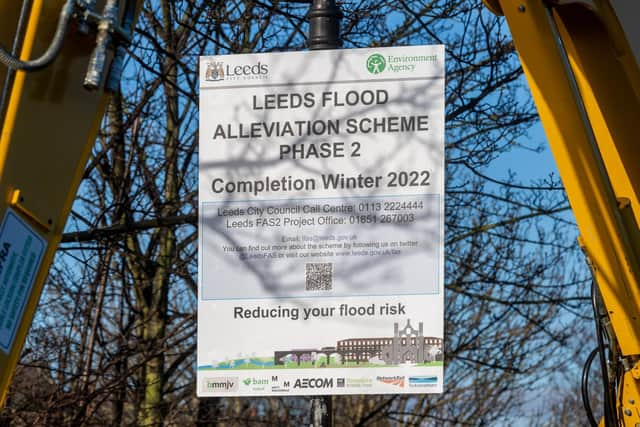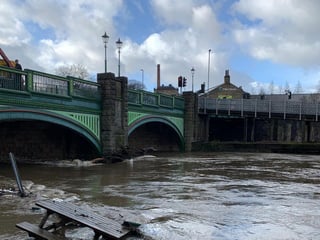Leeds Flood Alleviation Scheme - what flood defences are being built, when will it be finished and how much is it costing?
and live on Freeview channel 276
Those floods, caused by Storm Eva, cost Leeds an estimated £36.8m, with the cost to the wider city region being more than £500m.
What is the Leeds Flood Alleviation Scheme?


The Leeds Flood Alleviation Scheme is led by Leeds City Council in partnership with the Environment Agency and is split into two phases.
Advertisement
Hide AdAdvertisement
Hide AdThe first phase, completed in 2017, has seen formal flood defences installed along the River Aire for the first time.
It had been started in 2014, meaning it was planned before the floods caused by Storm Eva.
Work has also begun on a second phase, which is designed to give a one-in-200-year level of protection for Leeds against the threat of flooding.
It means the probability of the protected areas being flooded would be reduced to such an extent that it would only be likely to happen once in 200 years and with very significant rainfall.
Advertisement
Hide AdAdvertisement
Hide AdThere are other flood alleviation schemes designed to reduce the risk of flooding at Farnley Lane and Bridge Avenue in Otley, and to address homes being flooded in the areas surrounding Potternewton Park.
What work was carried out in phase one?
The project began with works completed downstream in Woodlesford, before moving into the city centre with measures including state-of-the-art mechanical weirs to control river levels.
There were three main elements - installing moveable weirs, a merging of the River Aire and the Leeds & Liverpool Canal, and creating flood walls, glazed panels and embankments stretching more than 4.5km.
The weirs at Crown Point in the city centre and further downstream at Knostrop can be lowered to create more room for flood water, with the potential of reducing flood levels by up to 1m.
Advertisement
Hide AdAdvertisement
Hide AdThe removal of a 600m stretch of land, known locally as Knostrop Cut island, has allowed the river and canal to merge. This has created additional capacity for flood water, helping to lower levels in flood conditions.
At Knostrop, a new locally manufactured bridge has been installed across the weir to connect the Trans Pennine Trail with the north bank of the river.
Flood defence walls have been constructed along the length of Hol Beck, which flows into the River Aire adjacent to Granary Wharf.
Elsewhere, low level embankments have increased the level of protection in Woodlesford.
How much is it costing?
Advertisement
Hide AdAdvertisement
Hide AdPhase one of the Leeds Flood Alleviation Scheme cost £50m, with phase two projected to cost £112m.
Funding for the first phase was secured through contributions from the council, Environment Agency, Defra, Regional Growth Fund, Leeds City Region Enterprise Partnership, Yorkshire Water and CEG.
The funding for phase two remains a sticking point after the Government offered a funding package of only around £65m. This has been boosted by funding from Leeds City Council, West Yorkshire Combined Authority and Network Rail - but the full amount needed is yet to be found.
Initial reports suggested the shortfall might be around £18.6m, with Leeds West MP Rachel Reeves later citing a figure of £25m. The latest figure being quoted for the shortfall is £23m.
What will phase two involve?
Advertisement
Hide AdAdvertisement
Hide AdPhase two of the scheme is the result of extensive survey and modelling work carried out in the wake of the 2015 floods.
It proposes a further £112m investment in a range of measures along the River Aire, including to its upper catchment.
This second phase will be delivered in two stages and uses natural flood management techniques to help slow the river's flow.
It will include building new walls and embankments, the removal of obstructions along the river to reduce water levels, the creation of new woodland areas, and creating a water storage area that releases water only when safe.
When will work begin on phase two?
Advertisement
Hide AdAdvertisement
Hide AdThe first step of phase two runs along an 8km stretch upstream of Leeds station and focuses on three key areas – Leeds Industrial Museum at Armley Mills, Kirkstall Abbey and Kirkstall Meadows.
Construction of flood defences for this first stage began in January with all the stage one works expected to be complete by winter 2022. The flood defence walls and embankments created in this stage of the works will provide a one-in-100 year level of protection.
The phase two works will upgrade the scheme to the full one-in-200 year protection level, but only once funding is found to cover the shortfall. This second stage will include creating a large flood storage area at Calverley, making use of an existing flood plain.
